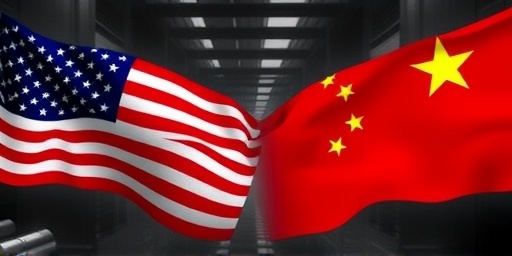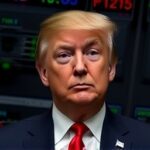In a move that could reshape global supply chains, the United States has officially implemented new tariffs on a wide range of Chinese imports, setting the rate at a reduced 47% effective immediately. This decision, announced by the White House earlier this week, aims to bolster domestic manufacturing but has ignited widespread concerns over rising inflation and escalating consumer prices across the American economy.
The tariffs target key sectors including electronics, apparel, and machinery, affecting billions in annual trade volume. Economists warn that while the rate is lower than the previously proposed 60%, the immediate impact could still add hundreds of dollars to household expenses, exacerbating inflationary pressures already straining the U.S. economy.
Tariffs Hit Key Imports: Electronics and Apparel in the Crosshairs
The rollout of these U.S.-China tariffs focuses primarily on consumer goods that form the backbone of everyday American shopping. Smartphones, laptops, and other electronics—many of which are assembled in China—now face an additional 47% duty, potentially driving up retail prices by 20-30% in the coming months. According to data from the U.S. International Trade Commission, Chinese imports accounted for over $500 billion in goods last year, with electronics alone representing nearly 40% of that figure.
Apparel and textiles, another major category, are also heavily impacted. Brands like Nike and Levi’s, which rely on Chinese manufacturing for cost efficiency, may see production costs soar. ‘These tariffs are a direct hit to our supply chain,’ said Sarah Thompson, supply chain director at a major U.S. retailer, in an interview with Reuters. ‘We’re already exploring alternatives in Vietnam and Mexico, but the transition won’t happen overnight, and consumers will feel the pinch first.’
The trade policy shift is part of a broader strategy to reduce U.S. dependence on Chinese manufacturing. Proponents argue it will create jobs in American factories, citing a recent study by the Economic Policy Institute that estimates up to 200,000 new manufacturing positions could emerge over the next five years. However, critics point out that short-term disruptions could lead to factory shutdowns in import-dependent industries.
Inflation Pressures Build as Supply Chains Strain
As the U.S.-China tariffs take hold, inflation concerns are mounting rapidly among policymakers and market watchers. The Federal Reserve has already raised interest rates three times this year to combat rising prices, but these new duties could push the Consumer Price Index (CPI) up by an additional 1.5-2% in the next quarter, according to projections from Goldman Sachs. This comes at a time when core inflation is hovering around 4.5%, well above the Fed’s 2% target.
Consumer prices for imported goods are expected to rise most sharply in the electronics and automotive sectors. For instance, the average cost of a new smartphone could increase by $150, while auto parts from China might add $500 to the price tag of a mid-range vehicle. ‘Inflation isn’t just a number on a chart; it’s groceries, gadgets, and gas for the average family,’ noted Dr. Elena Ramirez, an economist at the Brookings Institution. ‘These tariffs amplify existing pressures from supply chain bottlenecks post-pandemic.’
Businesses are scrambling to mitigate the fallout. A survey by the National Association of Manufacturers revealed that 65% of U.S. firms with Chinese suppliers plan to pass on at least half of the tariff costs to consumers. This could ripple through the economy, affecting everything from holiday shopping to corporate earnings. In manufacturing hubs like Ohio and Michigan, factory owners report delays in raw material shipments, leading to production slowdowns and potential layoffs.
- Electronics Sector Impact: Tariffs on semiconductors and components could raise PC prices by 25%.
- Apparel and Textiles: Cotton imports face duties, potentially increasing clothing costs by 15-20%.
- Machinery and Tools: Industrial equipment tariffs may hinder U.S. manufacturing expansion efforts.
The interplay between these U.S.-China tariffs and ongoing inflation underscores the delicate balance of trade policy. While aimed at protecting domestic industries, the measures risk fueling a cycle of higher costs that could dampen consumer spending, a key driver of U.S. GDP.
Trade Policy Shifts Echo Past Battles, Experts Sound Alarm
This latest escalation in U.S.-China trade policy revives memories of the 2018-2019 tariff wars, when similar duties led to a 0.5% spike in inflation and cost American consumers an estimated $50 billion annually. Back then, the tariffs covered $360 billion in goods; today’s implementation affects a similar scale but at the moderated 47% rate, negotiated after months of diplomatic wrangling.
Administration officials defend the policy, emphasizing its role in countering unfair trade practices. ‘China’s subsidies and intellectual property theft have undermined our manufacturing base for too long,’ stated Commerce Secretary Maria Gonzalez during a press briefing. ‘These targeted tariffs level the playing field and encourage reshoring of critical industries.’
Yet, market experts are divided. Wall Street analysts from JPMorgan predict a short-term GDP drag of 0.3% due to disrupted trade flows, while others see long-term benefits. ‘In the grand scheme, bolstering U.S. manufacturing could insulate us from future shocks,’ opined Mark Levin, chief economist at the Peterson Institute for International Economics. ‘But the transition period will be painful, with inflation as the immediate casualty.’
Globally, reactions are mixed. The European Union has expressed concerns over potential spillover effects, as higher U.S. consumer prices could reduce demand for European exports. Meanwhile, countries like India and Taiwan are positioning themselves as alternatives, with Indian manufacturing investments surging 25% year-over-year in anticipation of diverted trade.
Consumer Prices Surge: Real-World Impacts on American Households
For the average American household, the effects of these U.S.-China tariffs on consumer prices are already becoming tangible. A family of four could face an extra $800-1,200 in annual expenses, based on modeling from the Urban Institute. This includes not just direct imports but also domestically produced goods that use Chinese components, such as appliances and furniture.
In retail, big-box stores like Walmart and Target are bracing for the changes. Walmart, which sources 70-80% of its merchandise from China, has warned of price adjustments. ‘We’re committed to keeping prices low, but these tariffs force tough choices,’ said a company spokesperson. Early indicators show online prices for tariff-affected items rising by 10% within days of implementation.
Low-income families, who spend a larger share of their budget on essentials, stand to suffer most. The tariffs disproportionately hit affordable goods, widening the affordability gap. Advocacy groups like the Consumer Federation of America are calling for relief measures, such as expanded tax credits, to offset the burden.
Ol>
- Short-Term Price Hikes: Expect 15-25% increases on electronics and clothing by Q1 2024.
- Medium-Term Adjustments: Supply chain diversification could stabilize prices by 2025.
- Long-Term Shifts: Potential for U.S. manufacturing renaissance, reducing import reliance.
These consumer price dynamics highlight how trade policy intersects with everyday life, turning abstract economic decisions into concrete financial strains.
Manufacturing Revival on Horizon Amid Tariff Turbulence
Despite the immediate challenges, the tariffs are poised to invigorate U.S. manufacturing. The CHIPS Act and Inflation Reduction Act, passed in recent years, have already allocated $52 billion for domestic semiconductor production, complementing the tariff strategy. Companies like Intel and TSMC are expanding U.S. facilities, with Intel’s Ohio plant expected to create 3,000 jobs by 2025.
In the Rust Belt, optimism is growing. ‘These tariffs give us a fighting chance to bring jobs back home,’ said Tom Reilly, president of the Midwest Manufacturing Association. Pilot programs in states like Pennsylvania are testing tariff-exempt zones for reshored factories, aiming to attract investment.
However, success hinges on execution. Challenges include skilled labor shortages and higher domestic energy costs, which could offset tariff benefits. A report from McKinsey Global Institute suggests that full reshoring might take a decade, during which inflation from U.S.-China tariffs could persist.
Looking ahead, the implications are profound. If the tariffs successfully pivot trade policy toward self-sufficiency, they could shield the U.S. from geopolitical risks, such as tensions over Taiwan. Negotiations with China continue, with potential for exemptions in critical areas like rare earth minerals. Stakeholders from Congress to corporate boards are watching closely, as the next few quarters will determine whether this bold move curbs inflation or fans its flames further.
As businesses adapt and consumers adjust budgets, the true test of these policies lies in balancing protectionism with prosperity, ensuring that the pursuit of manufacturing strength doesn’t come at the expense of economic stability.









